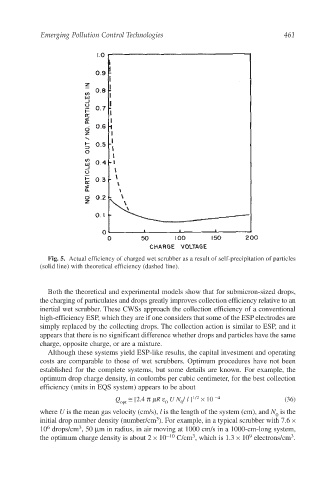Page 489 - Air Pollution Control Engineering
P. 489
12_ch_wang.qxd 05/05/2004 5:26 pm Page 461
Emerging Pollution Control Technologies 461
Fig. 5. Actual efficiency of charged wet scrubber as a result of self-precipitation of particles
(solid line) with theoretical efficiency (dashed line).
Both the theoretical and experimental models show that for submicron-sized drops,
the charging of particulates and drops greatly improves collection efficiency relative to an
inertial wet scrubber. These CWSs approach the collection efficiency of a conventional
high-efficiency ESP, which they are if one considers that some of the ESP electrodes are
simply replaced by the collecting drops. The collection action is similar to ESP, and it
appears that there is no significant difference whether drops and particles have the same
charge, opposite charge, or are a mixture.
Although these systems yield ESP-like results, the capital investment and operating
costs are comparable to those of wet scrubbers. Optimum procedures have not been
established for the complete systems, but some details are known. For example, the
optimum drop charge density, in coulombs per cubic centimeter, for the best collection
efficiency (units in EQS system) appears to be about
Q ≅ [2.4 π µR ε UN / l ] 1/2 × 10 −4 (36)
opt 0 0
where U is the mean gas velocity (cm/s), l is the length of the system (cm), and N is the
0
initial drop number density (number/cm ). For example, in a typical scrubber with 7.6 ×
3
6
3
10 drops/cm , 50 µm in radius, in air moving at 1000 cm/s in a 1000-cm-long system,
3
9
3
the optimum charge density is about 2 × 10 −10 C/cm , which is 1.3 × 10 electrons/cm .

